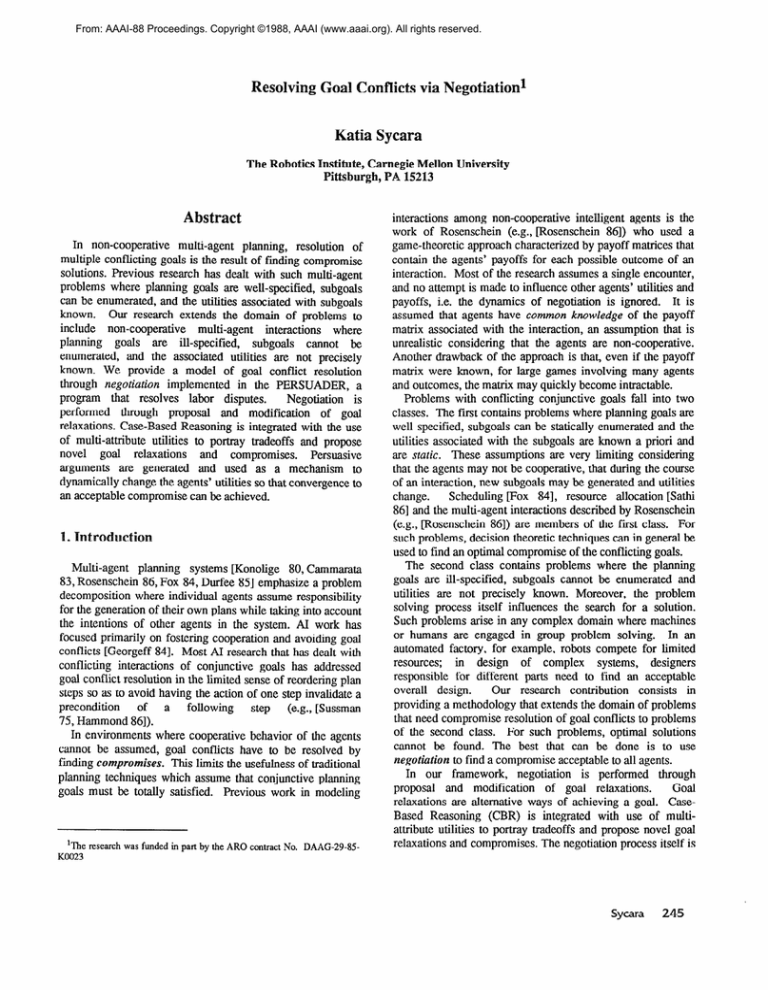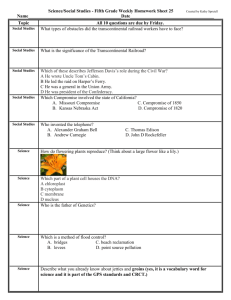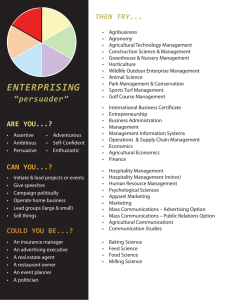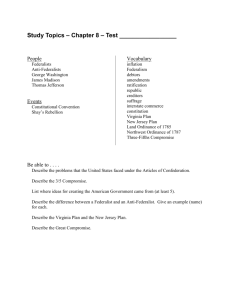
From: AAAI-88 Proceedings. Copyright ©1988, AAAI (www.aaai.org). All rights reserved.
Resolving Goal Conflicts via Negotiation1
Katia Sycara
The Robotics Institute, Carnegie Mellon University
Pittsburgh, PA 15213
Abstract
In non-cooperative multi-agent planning, resolution of
multiple conflicting goals is the result of finding compromise
solutions. Previous research has dealt with such multi-agent
problems where planning goals are well-specified, subgoals
can be enumerated, and the utilities associated with subgoals
known. Our research extends the domain of problems to
include non-cooperative
multi-agent
interactions
where
planning
goals are ill-specified,
subgoals cannot be
enumerated, and the associated utilities are not precisely
known. We provide a model of goal conflict resolution
through negotiation implemented in the PERSUADER, a
program that resolves labor disputes.
Negotiation is
performed through proposal and modification of goal
relaxations. Case-Based Reasoning is integrated with the use
of multi-attribute utilities to portray tradeoffs and propose
novel goal relaxations
and compromises.
Persuasive
arguments are generated and used as a mechanism to
dynamically change the agents’ utilities so that convergence to
an acceptable compromise can be achieved.
Multi-agent planning systems [Konolige 80, Cammarata
83, Rosenschein 86, Fox 84, Durfee 851 emphasize a problem
decomposition where individual agents assume responsibility
for the generation of their own plans while taking into account
the intentions of other agents in the system. AI work has
focused primarily on fostering cooperation and avoiding goal
conflicts [Georgeff 841. Most AI research that has dealt with
conflicting interactions of conjunctive goals has addressed
goal conflict resolution in the limited sense of reordering plan
steps so as to avoid having the action of one step invalidate a
precondition
of
a
following
step
(e.g., [Sussman
75, Hammond 861).
In environments where cooperative behavior of the agents
cannot be assumed, goal conflicts have to be resolved by
finding co~~rom&es. This limits the usefulness of traditional
planning techniques which assume that conjunctive planning
goals must be totally satisfied. Previous work in modeling
‘The research was funded in part by the AR0 contract No. DAAG-29-85KOO23
interactions among non-cooperative intelligent agents is the
work of Rosenschein (e.g., IRosenschein 861) who used a
game-theoretic approach characterized by payoff matrices that
contain the agents’ payoffs for each possible outcome of an
interaction. Most of the research assumes a single encounter,
and no attempt is made to influence other agents’ utilities and
payoffs, i.e. the dynamics of negotiation is ignored. It is
assumed that agents have common knowledge of the payoff
matrix associated with the interaction, an assumption that is
unrealistic considering that the agents are non-cooperative.
Another drawback of the approach is that, even if the payoff
matrix were known, for large games involving many agents
and outcomes, the matrix may quickly become intractable.
Problems with conflicting conjunctive goals fall into two
classes. The first contains problems where planning goals are
well specified, subgoals can be statically enumerated and the
utilities associated with the subgoals are known a priori and
are static. These assumptions are very limiting considering
that the agents may not be cooperative, that during the course
of an interaction, new subgoals may be generated and utilities
change.
Scheduling [IFox 841, resource allocation [Sathi
861 and the multi-agent interactions described by Rosenschein
(e.g., posenschein 861) are members of the first class. For
such problems, decision theoretic techniques can in general be
used to find an optimal compromise of the conflicting goals.
The second class contains problems where the planning
goals are ill-specified, subgoals cannot be enumerated and
utilities are not precisely known. Moreover, the problem
solving process itself influences the search for a solution.
Such problems arise in any complex domain where machines
or humans are engaged in group problem solving. In an
automated factory, for example, robots compete for limited
resources;
in design of complex systems, designers
responsible for different parts need to find an acceptable
overall design.
Our research contribution consists in
providing a methodology that extends the domain of problems
that need compromise resolution of goal conflicts to problems
of the second class. For such problems, optimal solutions
cannot be found. The best that can be done is to use
9zegotiation to find a compromise acceptable to all agents.
In our framework, negotiation is performed through
proposal and modification of goal relaxations.
Goal
relaxations are alternative ways of achieving a goal. CaseBased Reasoning (CBR) is integrated with use of multiattribute utilities to portray tradeoffs and propose novel goal
relaxations and compromises. The negotiation process itself is
Sycara
245
a search of a dynamic problem space where an agent’s beliefs
about other agents’ beliefs over the cycle of proposals
continuously changes the space being searched. What was not
a solution at one point becomes a solution at a later point2.
Persuasive arguments are generated and used as a mechanism
to dynamic&y change the agents’ utilities associated with the
conflicting goals so that convergence to an acceptable
compromise can be achieved.
Our theory of goal conflict resolution is implemented in the
PERSUADER, a program which, acting as a labor mediator,
enters in negotiation with each of the parties, the union and
company, proposing and modifying compromises and utilities
until a final agreement is reached. We used two practicing
Federal Mediators as experts: one for development and the
other for informal validation3. Although the program operates
in the domain of labor relations, the techniques it uses are
domain independent. The PERSUADER is a complex system.
In the allotted space, we can only present a simplified and
somewhat high level view of the system.
2. Requirements of a Planner for Resolution of
Goal Conflicts (RGC)
A planner for RGC via negotiation has as input the
conflicting goals of multiple agents and as output a
compromise acceptable by the agents. For continuum-valued
issues the choices that such a planner has are infinite.
Hierarchical decomposition of the problem into smaller
subproblems each of which is easier to solve may not be
suitable, since a compromise solution may be a “package”
whose parts are strongly interconnected and interacting,
These difficulties are compounded by the absence of a
coherent set of constraints that could guide search through the
space of all possible
compromises.
The problem
characteristics impose some requirements on a planner for
RGC via negotiation:
0 Conflict resolution involving multiple agents with
conflicting goals is a cooperative search problem.
The planner must guide the agents through a
sequence of possible compromises to a final
compromise that is acceptable by all. Therefore,
a planner for RGC needs to plan in an iterative
rather than a one shot fashion.
e Since the expertise resides in the agents, they
have to give feedback to the conflict resolver,
about which tradeoffs are acceptable. Hence, a
planner for RGC needs to be able to receive
feedbuck about the quality of its plan, evaluate it,
21n labor negotiations, for example, it is unlikely that either party would
accept their eventual compromise, if it were presented at the inception of
negotiations.
3Since Federal Mediators are required by law to destroy all documents and
notes pertaining to a case, it was not possible to validate the system by
running real cases.
244
Cognitive Modeling
and use it to generate a counterproposal.
0 During the course of negotiations, conditions in
the world that affect the agents’ behavior and
goals might change. Therefore, a planner for
RGC needs to be able to react to the changing
planning context.
e A planner for RGC must have a way of
new
whether
each
predictinglevaluating
counterproposal leads toward convergence.
0 A planner for RGC needs to have a component
that generates persuasive arguments to change
the parties’ utilities.
In the rest of the paper, we present the PERSUADER as a
model of RGC via negotiation. It incorporates all the above
characteristics.
The PERSUADER’s input is the set of conflicting goals of
the company and union, and the dispute context. Its final
output is either a single plan in the form of an agreed upon
compromise, or an indication of failure if the parties to the
dispute did not reach agreement within a particular number of
proposals.
The PERSUADER’s tasks are: (a) propose an
initial compromise, (b) repair and improve a rejected
compromise, (c) persuade the parties to change their
evaluation of a compromise. The PERSUADER views these
tasks as planning tasks.
As shown in Figure 1, to perform its tasks, the
Case-Based
Reasoning
(e.g.,
PERSUADER
integrates
[Kolodner et al. 85, Hammond 861 (a heuristic technique) and
Preference Analysis (a decision theoretic, analytic method).
Expert labor negotiators/mediators take into consideration
behavior of similar
prevailing practice, the bargaining
disputants, as well as informal notions of the parties’ utilities
in coming up with an acceptable compromise. In our work,
prevailing practice is abstracted to Case-Based Reasoning
(CBR), and the parties’ utilities are modeled through
Preference Analysis.
Three foci, contracts, impasses and
arguments are used as basis for Case-Based Reasoning at
performing the above tasks. The PERSUADER keeps track of
compromises that have worked in the past in similar
circumstances. The most suitable is retrieved from memory
and adapted to fit the current situation. The compromise is
then proposed to the parties. If the parties agree, the case
memory is updated with a successful episode. If one of the
parties disagrees, the PERSUADER either repairs the
compromise to better accommodate the rejecting party’s
utilities, or generates arguments to change the utilities of the
disagreeing party with respect to the rejected compromise.
Successful plans that satisfy conjunctive goals totally or
partially and their justifications are stored in memory so that
they can be reused in similar situations. Failures (impasses)
and their failure reason (if one can be found) are also stored so
Figure 1: Goal Conflict Resolution via Negotiation
that they can be recalled in situations with similar features to
the one where the failure occurred, thus warning the problem
solver about potential problems.
Unlike other case-based
planners (e.g. [Hammond 863) that only avoid problems that
they can anticipate at the beginning of planning, in the
PERSUADER, warning/avoidance of problems occurs at each
decision point.
The PERSUADER’s architecture is particularly suited to
negotiation, a task characterized by lack of a strong domain
model, many and complex planning steps, and lack of certain
or complete knowledge. Case-Based Reasoning (CBR) allows
for increased planning efficiency by reusing successful plans
and avoiding past mistakes. Re-using successful plans
provides a quality of solution unobtainable by traditional
planners which are dependent on well-defined goals and
operators and strong domain models. Traditional planners
(e.g. [Sussman 751) build plans for each individual goal and
then deal (i.e try to avoid) with any interactions as they arise.
Such a method is clearly unsuitable for RGC where tradeoffs
must be made. CBR can be combined with decision-theoretic
techniques, such as Preference Analysis, to improve the
quality of solutions.
ise
The PERSUADER uses two methods to construct an initial
compromise: CBR and Preference Analysis. We give a brief
presentation of the methods. For more detail see [Sycara 871.
CBR consists of the following steps:
(a) Retrieve
appropriate precedent cases from memory, (b) Select the most
appropriate case from those retrieved, (c) Construct a
“ballpark” plan based on the selected precedent, (d) Evaluate
the “ballpark” plan for applicability to the current case, (e)
Adapt the “ballpark” plan to fit the current problem situation.
To retrieve a set of cases similar to the current one, the
PERSUADER uses a set of salient features of the domain
(e.g., industry, geographical location) as memory probes. An
evaluation function based on a prioritization of the features is
used to select the best (most similar case). Knowledge is
extracted from the solution part (the contract) of the selected
case, and adjusted through standard adjustments to form the
“ballpark” solution which is further adapted to the current
case. A final check for unforeseen problems is then performed
through intentional reminding [Schank 821 of failures. The
conjunction of the solution’s features are used as indices to
retrieve failures that have the same features as the
contemplated compromise. If an associated repair is stored
along with the retrieved failure, the planner can apply the
repair to the compromise.
Sycara
247
Consider, for example, the PERSUADER trying to find a
compromise for the Getaway transit transport company and its
union. The union wants 15% wage increase, 7% increase in
pensions, and no subcontracting. The company wants no wage
increase, no pension increase, and unlimited subcontracting.
The PERSUADER
searches memory for similar past
contracts. The most similar are contracts of competitors. Out
of those, it selects the contract of Bluehound transit company
since its location (Alabama, a southeastern state) is similar to
Getaway’s (Georgia).
This contract provided 12% wage
increase, 5% pension increase and unlimited subcontracting.
Next, the Bluehound contract needs adjustment. This is
done using known heuristic modifications in labor mediation,
namely adjustments with respect to the competitors’ position
in industry, and area wage differentials between Alabama and
Georgia. These adjustments result in 11% wage increase, 4%
increase in pensions and limited subcontracting only when
extra work is available.
The PERSUADER now adapts the ballpark compromise to
the current situation. Checking the financial situation of the
company, it finds out that Getaway has suffered 4% losses in
the past three years. It searches memory for similar cases,
selects the most similar and applies the heuristic used in that
case.
Searching memory with index
TRANSIT-TRANSPORT
and CONTINUOUS-LOSS
3 cases found
Select case2
since it is same area, same company size
Apply heuristic used in this case
Decrease wage increases by half percentage of losses
Wage increase becomes 9%
Before
proposing
the updated
compromise,
the
PERSUADER
searches memory to discover potential
problems with the contemplated subcontracting language
(with indices “failure”, “subcontracting language, “limited to
extra work”). It retrieves a case where the union had filed a
grievance protesting that the company, having extra work,
resorted to subcontracting for long periods of time instead of
hiring more workers. The arbitrator in that case did not
vindicate the union because no time limitation was written in
the contract but proposed that the union get a time.limitation
for its next contract.
Searching memory with index FAILURE,
SUBCONT-LANG, LIMITED-EXTRA-WORK
1 case found
Apply repair used in this case
Put time limit in subcontract language
If previous
similar cases are not available,
the
PERSUADER uses Preference Analysis [Sycara 87, Sycara
881 to find suitable compromises. Preference Analysis is based
on Multi-Attribute Utility Theory [Keeney 761. The utilities of
each agent associated with each of the conflicting goals are
used to rank possible compromises.
The PERSUADER
derives the utilities of the agents by using utilities of similar
agents that it has encountered. If no such past experiences are
available, the PERSUADER uses a set of domain-specific
heuristics to select the appropriate utilities from a set of utility
Cognitive Modeling
functions that it knows about. The linear combination of the
utilities associated with an agent’s goals forms the payoff of
the agent with respect to a compromise. The compromise that
the planner selects to propose is the one that maximizes the
joint payoff of the agents and minimizes the payoff difference.
This criterion combines maximal gains with equity. For more
details, see [Sycara 881.
5. Reactive Phase
In iterative planning, such as RGC through negotiation,
feedback from the environment may inform the planner that
his plan is unacceptable. The PERSUADER has two ways of
reacting to negative feedback (rejection of the solution/plan):
changing the rejecting agent’s evaluation of the plan through
argumentation [Sycara 85, Sycara 871, and
persuasive
modifying/repairing
the plan so that it will be more
acceptable. Persuasive argumentation is tried fiist, since, if
the objecting agents can be convinced to relax their utilities
and accept the compromise, then a successful resolution has
been found. If, on the other hand, a rejected compromise is
modified/repaired, the repair may make it objectionable to
agents that had agreed before.
5.1. Generating Arguments
The PERSUADER’s planning goal during argument
generation is to change the belief structure of another agent,
the persuadee, with respect to a proposed compromise.
“Convincing” someone can be modeled as increasing the
payoff that the compromise gives him. Hence, the task of a
persuader can be viewed as finding the most effective
argument that will increase the agent’s payoff. Since an
agent’s payoff can be approximated by a linear combination of
his utilities, his payoff can be increased by (a) changing the
importance (coefficient) the agent attaches to an issue, and (b)
by changing the utility value of an issue. These constitute a
persuader’s argumentation goals. In labor mediation, the
mediator is the persuader and the union or company the
persuadee.
The PERSUADER’s model of a persuadee’s goals is a
directed acyclic graph, called a belief structure. It is searched
and updated during argument generation. The nodes are goals
with the associated importance, utility value, and desired
direction of change (increase or decrease). The arcs represent
the percent contribution of a goal to each of its ancestor goals.
For example, an increase in wages contributes to increases in
In contrast, the subgoal of
total company labor costs.
decreasing employment contributes to a decrease in labor cost.
The argument, addressed to a union that has refused a
proposed wage increase, “If the company is forced to grant
higher wage increases, then it will decrease employment” is
meant to decrease the importance the union attaches to wage
increases by pointing out unpleasant consequences for the
union of forcing an unwanted by the company wage increase.
To generate the above argument, the PERSUADER
matches the wage goal in the company’s belief graph. It
propagates the wage increase that the union wants to force to
the ancestors of the wage goal (e.g., economic concessions,
total labor cost, production cost, profits). Children of these
nodes might indicate subgoals that the company can fulfill to
counteract the wage increase. Such a counteracting action that
violates a union goal that is more important than the union
wage increase constitutes an argument that is aimed at
reducing the importance that the union attaches to wage
increase.
Importance for wage-goal1 is 6 for union1
Searching company1 goal-graph...
A increase in wage-goal1 by company1
will result in a increase in econ-concessionsl,
labor-costl, production-cost1
To compensate, company1
can decrease fringe-benefits 1, employment 1
which violates goals for union1
Importance of fringe-banefitsl is 4 for union1
Importance of employment1 is 8 for union1
Importance of employmentl>importance of wage-goal1
One possible argument found
5.2. Repairing Rejected Compromises
When a rejected solution needs to be improved, the,
PERSUADER ascertains from the rejecting agent’s feedback
the most objectionable goal, the reason for the rejection and
the importance the agent attaches to the goal. The rejected
goal and reason are used as probes to select impasses with the
same stated impasse goal and impasse cause as in the present
impasse to supply improvements. If no appropriate impasses
can be found, the PERSUADER uses standard heuristics that
it knows about.
The PERSUADER’s strategy for repair is explanationbased where the explanation (reason for rejection) is supplied
by the rejecting agent. This is realistic for complex domains
where there is no strong domain model, hence automatic
explanation methods are not applicable. The PERSUADER
thus uses a combination of similarity-based retrieval (during
initial compromise generation) and an explanation-based
retrieval (during repair of a failed compromise).
For example, confronted with the company’s objection that
it cannot afford the proposed “economic package”, the
PERSUADER recalls impasses that have failed for the same
reason and examines the associated repairs.
Searching memory with index FAILURE,
WON-PKGE, INABILITY-TO-PAY
5 impasses found
Select impasse1
since it is same industry, same area
Looking at the repair
“pass the extra cost to the consumer” in impasse1
Since demand for product city transit service
is INELASTIC, repair seems applicable
In multivariate planning there are many ways a plan could
be modified/repaired.
A planner seeks not only a plausible
repair but one that with some confidence improves the rejected
The criterion of plan improvement
that the
plan.
PERSUADER uses is whether the contemplated repair
increases the rejecting agents’ payoff more than it might
decrease the payoff of the agents who have agreed to the
compromise. Without an ability to predict which repair has a
chance of being accepted, the planner could propose repairs
that do not converge.
6. Concluding
Remarks
We have presented the PERSUADER as a model of RGC
among conjunctive goals through negotiation for problems
subgoals and
with ill-specified
goals, non-enumerable
The PERSUADER plans
unknown associated utilities.
iteratively by interacting with the agents, using their feedback
in refining and repairing compromises, and in generating
persuasive arguments. The PERSUADER plans for labor
mediation, a domain full of uncertain knowledge and changing
circumstances. Efficient planning is provided by:
@having good criteria to evaluate compromises. In
our model, these criteria are provided through
Preference Analysis.
e avoiding bad proposals. In our model, this is done
through CBR and Preference Analysis.
e having models of other agents’ intentions. In our
model this is done through a memory for cases.
The integration of analytic and heuristic methods makes the
PERSUADER robust and flexible. It does not break down
when heuristic methods fail. Moreover, it has the flexibility to
use whichever method is more natural to the particular
problem solving stage it is engaged in.
eferences
[Cammarata 831 S. Cammarata, D. McArthur, R. Steeb.
Strategies of Cooperation in Distributed
Problem Solving.
Tech Report N-203 1-ARPA, The Rand
Corporation, 1983.
[Durfee 853
E. Durfee, V. Lesser, and D. Corkill.
Coherent Cooperation Among
Communicating Problem Solvers.
Technical Report, Department of Computer
Science and Information Science,
University of Massachusetts - Amherst,
Massachusetts 01003, September, 1985.
[Fox 841
Fox, M.S. and Smith, S.F.
ISIS: A Knowledge-Based System for
Factory Scheduling.
Expert Systems 1:25-49, 1984.
[Georgeff 841
Georgeff, M.A.
Theory of action for multi-agent planning.
In m-84,
pages 121-125. AAAI, Austin,
TX, 1984.
Sycara
249
mmond
861
[Keeney 761
Hammond, K.J.
CHEF A model of case-based planning.
In AAAI-86, pages 267-271. AAAI,
Philadelphia, PA, 1986.
Keeney, R.L. and Raiffa, H.
Decisions with Multiple Objectives.
John Wiley and Sons, New York, 1976.
[Kolodner et al. 851
Kolodner, J.L., Simpson, R.L., and SycaraCyranski, K.
A process model of case-based reasoning in
problem solving.
In IJCAI-85, pages 284-290. IJCAI, Los
Angeles, CA, 1985.
[Konolige SO]
Konolige, K, and Nilsson, N. J.
Multiple-Agent Planning Systems.
In AAAI-80, pages 138-142. AAAI,
Stanford University, Palo Alto, CA.,
1980.
mosenschein 861 J. Rosenschein.
Rational Interaction: Cooperation Among
Intelligent Agents.
PhD thesis, Department of Computer
Science, Stanford University, 1986.
Also appeared as Technical Report STANCS-85-1081.
[Sathi 861
Sathi,A., Morton, T.E., andRoth, S.
Call&o: An Intelligent Project
Management System.
AI Magazine 7:34-57,1986.
[Schank 821
Schank, R.C.
Dynamic Memory.
Cambridge University Press, Cambridge,
1982.
[Sussman 751
Sussman, G.
A computer model of skill acqusition.
American Elsevier, New York, 1975.
[Sycara 851
[Sycara 871
Sycara-Cyranski, K.
Arguments of persuasion in labor
mediation.
In IJCAI-85, pages 294-296. IJCAI, Los
Angeles, CA, 1985.
Sycara, K.
Resolving Adversarial Conflicts: An
Approach Integrating Case-Based and
Analytic Methods.
PhD thesis, School of Information and
Computer Science Georgia Institute of
Technology, 1987.
[Sycara 881
Sycara, K.
Utility Theory in Conflict Resolution.
Annals of Operations Research 12~65-84,
1988.
250
Cognitive Modeling



